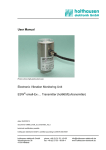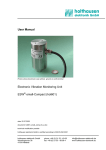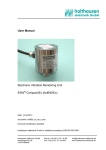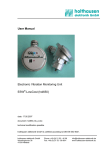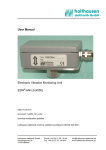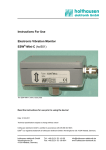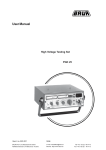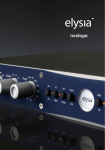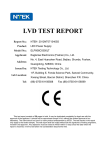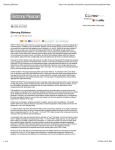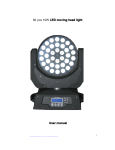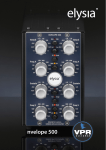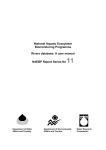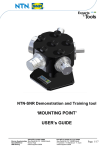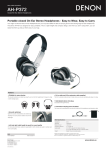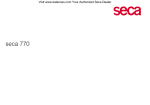Download Small-Transmitter (hol603) User Manual
Transcript
holthausen elektronik GmbH User Manual Picture shows high-grade-steel-case Electronic Vibration Monitoring Unit ESW®-small-Transmitter (hol603/transmitter) date: 09/02/2015 document: hol603_small_transmitter_hb_e technical modification possible holthausen elektronik GmbH is certified according to DIN EN ISO 9001 holthausen elektronik GmbH Wevelinghoven 38 41334 Nettetal phone: +49 (0) 21 53 - 40 08 fax: +49 (0) 21 53 - 89 99 4 [email protected] www.holthausen-elektronik.de holthausen Electronic Vibration monitoring Unit ESW®-small-Transmitter elektronik GmbH Table of Contents 1. Generally basical safety-indications .............................. page 4 2. Packing and the transport ............................................. page 4 3. Application..................................................................... page 5 4. Measurement principle .................................................. page 6 5. Connection technology .................................................. page 6 6. Grounding concept ........................................................ page 8 7. Mounting of the vibration control unit ............................ page 9 8. Opening and closing of the vibration control unit........... page 10 9. Maintenance.................................................................. page 10 10. Display- and operation- elements.................................. page 10 12. Housing size.................................................................. page 11 13. Cable connection draft .................................................. page 12 14. Declaration of Conformity .............................................. page 13 Technical Data .............................................................. appendix 2 holthausen Electronic Vibration monitoring Unit ESW®-small-Transmitter elektronik GmbH Important information These operation instructions are to be read through completely and carefully heeded before starting the device. Failure to heed or adhere can result in claims on manufacturer’s liability becoming null and void for damages ensuing there from. Manual action of any manner on the device – with the exception of proper procedures and those described in these operation instructions – lead to forfeit of guarantee and exclusion from liability. The device is solely intended for the usage as described below. It is particularly not intended for the direct or indirect protection of persons. holthausen elektronik GmbH assumes no liability whatsoever as regards suitability for some specific purpose. If any question should remain open, please never hesitate to contact us. holthausen elektronik GmbH Wevelinghoven 38, 41334 Nettetal Phone: +49 (0) 21 53 - 40 08 Fax: +49 (0) 21 53 - 8 99 94 Mail: [email protected] 3 holthausen Electronic Vibration monitoring Unit ESW®-small-Transmitter elektronik GmbH 1. Generally basical safety-indications Don’t use this device as the only invigilator, if a malfunctioning of ESW ®-Compact/Ex could lead to damages on goods or Persons. To obtain the desired result be sure, that the device with its technical data fits to the bulk of the object you want to supervise. The sensor is sensitive to shock. A downfall out lower height to a hard substratum can destroy the sensor. The assembling place and the execution of the assembling of the sensor determine decisively the quality of the sensor signal. The assembling may only happen through qualified and instructed persons. The electrical hook up is to be done by instructed persons. A mistake by the connection can entail to faulty functions, outfall or ruination of the sensor and electronics. The ESW ® should not be used on machines with a very energetic high-frequency solidborne. Through resonance apparitions in the sensor, the device can indicate a much too great or too small value. Powerful noise sources for instance inverters, in direct closeness of the sensor, electronics or cabling, can result in faulty behaving of the apparatus. Potential differences and balance currents in the mass guidance can result in faulty behaving too. The connection cable is resistant against many but not every type of chemical and mechanical stress. Through a damaged cable chemicals could get inside the unit and destroy the electronic. Then the unit would loose their function. Therefore the conditions from the mounting surrounding must be checked. Then the cover material from the cable have to be proofed if it resists these requirements. You can get an overview from the chemical resistance of the cover material from us. 2. Packing and the transport Note: • The sensor is sensitive to shock. A downfall out lower height to an hard substratum can destroy the sensor. • Avoid to kink or tie a knot in the cable. • Keep the electronic in a dry place. • In case of a downfall or heckling or squeezing, could the casing or the operation elements or the board get defects. With adequate warning-labels and through a qualified packaging and storage, you can protect the sensor and electronics at carriage against influences from outside. 4 holthausen Electronic Vibration monitoring Unit ESW®-small-Transmitter elektronik GmbH 3. Application In many technical ranges there are vibrations, frequently are they to neglect or even necessary, but sometimes also undesirable or even dangerous. Beside that, can dangerously vibration-conditions start slinking or occur total unexpected. The reason for it often lies in mechanical defectives or improper handling of the machine. The sequences are maybe diminution of the product quality or even loss of production and endangering of the security, at least a raised wear and tear. Increasing automation as well as a high noise level, prevents often an acoustically or visual surveillance. Thereby offers early detection, taking care of the material and limitation of damage a considerable potential to the reduction in costs. The ESW ®-small-Transmitter monitors the vibration level for continuous process and outputs a current or voltage at the analog output, which is proportional to the vibration acceleration. The frequency range result from the characteristics of the measured object and the environmental reference. In order to tune the device optimally to the vibration problem, the measuring and frequency range can be adapted ex-factory. Either the vibration speed or the vibration acceleration can be selected as the quantity measured. Depending on the measured object occurs the signal estimation according to the crest value or the effective value of the measurement. Particular attention should be donated to the assembling place of the sensor, decisively is the source of the signal that shall be measured and its mean vibration direction. The assembling place of the sensor and alignment of the measurement axis of the sensor have to be selected so that the vibration possibly can be measured directly without interferences, subdued crossings or defective couplings. 5 holthausen Electronic Vibration monitoring Unit ESW®-small-Transmitter elektronik GmbH 4. Measurement principle The vibration-monitoring unit is generally mounted on the place, where inadmissible vibration occurs or can be expected. The unit is permanently monitoring the real condition or situation on the machine. The noticed mechanical vibration detected by the sensor will be transformed to a corresponding electrical signal. The sensor converts mechanical oscillations into an electrical alternating voltage. The subsequent electronics converts the AC signal into a DC voltage, which is equivalent to the measured oscillation speed. A current in the range 0 to 20mA or 4 to 20mA or a voltage in the range 0 to 10V which is proportional to the measured value and corresponds to the measuring range is delivered over the “analog output” cable terminals. 5. Connection technology The ESW ®-small-Transmitter is available in two different basic versions. Conventional technique This version is designed in such a way that two conductors are used for power supply and two conductors are used for the analog output. Two-conductor technique Although the term is defined, there are various interpretations of the same. In order to avoid misunderstanding, a brief description of the use of the device is given below. A) Voltage is measured across the load resistance, which is proportional to the current, and thus to the measured value: (RL) ESW Load resistance + Supply Voltage signal B) The current is measured using an ampermeter (e.g. SPS), which is proportional to the measured value: + ESW 4-20mA input e.g. SPS Supply 6 holthausen Electronic Vibration monitoring Unit ESW®-small-Transmitter elektronik GmbH The voltage drop across the load resistance (sketch A) is directly proportional to the current flowing through the resistor (Ohm's law: U = R x I) and thus corresponds to the acceleration. An ammeter (sketch B) can, e.g., be the input (4 to 20mA) of an SPS. The load resistance and the internal resistance of the current input may not exceed a certain maximum value depending on the supply voltage. The supply voltage must thus be selected in such a way that it is larger than the minimum supply voltage (10V) and the voltage drop across the load and the internal resistance. U b > U min + U R The device operates linearly up to 22mA output current. However a maximum current of 27mA can occur when the measuring range is crossed. Formula for calculation of the maximum load and internal resistance: RL = U b − U min I max Examples: Supply: 12V DC RL = (12V - 10V) / 27mA = 74 Ω max. Supply: 24V DC RL = (24V - 10V) / 27mA = 518,5 Ω max. Supply: 30V DC RL = (30V - 10V) ) / 27mA = 740,7 Ω max. 7 holthausen Electronic Vibration monitoring Unit ESW®-small-Transmitter elektronik GmbH 6. Grounding concept main control box with power supply optional connection box vibration control unit shield shield +Ub -Ub signal ground signal ground vibration control unit ground local vibration control unit ground connection box ground local connection box ground main control box ground local main control box ground If an isolated installation is not specially requested, usually through the attachment with screws each case is connected to the local machine ground. In big facilities with considerable energy consumption and distances between the machines could such big potential difference be build up, that substantial balancing current on the ground network will occur. Dependent on intensity of such currents is arising of interference’s or damaging of the unit the result! Potential differences could also arise on machines, with small distances not clear crossing of ground potential for example painted color or movable parts like suspension mounting. Energetic high frequency interference energy could be added to the measurement signalwire by inductivity or trough capacity that could change the real existing measurement value! In this way, for example parallel going elements could act as coupling-capacitor and winded up grounding cable could act like a cut off choke. Memorize: Ground is not equal everywhere! Check the situation Plan the grounding concept Select the facility / realization 8 holthausen Electronic Vibration monitoring Unit ESW®-small-Transmitter elektronik GmbH 7. Mounting of the vibration control unit - Whole mounting-, connecting- and adjustment-work should be done from qualified personal only! - Protect the ESW®-small-Transmitter definitely against drop, stroke and other mechanical shock! - The case of the unit must be connected over the attachment or the ground-on-earthTerminal with the potential compensation of the monitored machine. The connection must be extremely low resistive as well as for long time stable. Doing this, take urgent notice to the valid VDE-regulations. SW22 Surface A >18,0 10,0 max. top hole screw locked M10x25 with LOCTITE protection M10 0,03 A >ø55 The ESW ®-small-Transmitter will be mounted via one threaded pin AM10*25 per DIN 913 on the machine to be monitored. Important 1. Measuring axis has to be coinciding with vibration excitation axis (see case drawing page 12). 2. Take note of the label with instruction notes. 3. The surface has to be plain, clean and free of paint and rust. 4. The tap hole has to be perpendicular to the surface and free of metal-cuttings or other foreign material. Further more the tap hole and the screw have to be free of paint, rust, grease or other isolating components. 5. The grub screw has to be locked with liquid thread protection against unintended loosening. 6. The unit has to be fixed, tight on the surface. 7. The advises to „connection cable“ (page 8), as well as „Opening and closing of the vibration control unit “ (page 11) are absolutely to note. 9 holthausen Electronic Vibration monitoring Unit ESW®-small-Transmitter elektronik GmbH 8. Opening and closing of the vibration control unit The user must switch off the power supply, before opening the measurement unit. To open the unit the user needs a 0,9mm type of wrench “inbus - key“ and a forehead key with twobore nut, with size of 4mm. The case cover is ensured with a M2 screw. These must be loosened before opening of the case cover, with an “inbus - key”. After adjustment of the unit, please control the position of the DIP-switches Before closing the unit the O-Ring must be examine. You have to insert a new O-Ring (43 x 2mm, Si 970 FL – original spare part) if the old one is brittle, deformed, damaged or already a few month in use. Please pay attention that the thread and the interior room is oil- and dirt- free. Cleaning around and inside the unit should be done only with clean and dry cloth. The closing and the sealing of the unit is done after app. seven pitches of cover-nut thread, and ensured via the M2 screw. Advises for dismantling Before dismantling the measurement unit, the power supply must be switched off. The connection cable has to be loosened from the supporting surface to avoid damaging of the cable. The vibration control unit should be set free via a 22mm wrench key. 9. Maintenance The ESW ®-small-Transmitter is maintenance free. Tools for case cover opening: 0,9mm type of wrench (Inbus-key) Adjustable forehead key for two bore nut size 4mm Factory: H. Sartorius Nachf. GmbH & Co phone +49 (0) 21 02 / 44 00 - 0 fax +49 (0) 21 02 / 44 00 - 24 10. Display- and operation- elements The display elements will be accessible after unscrewing the cover of the ESW ®-small-ExTransmitter. Display elements LED green on LED Operating voltage “on“ 10 holthausen Electronic Vibration monitoring Unit ESW®-small-Transmitter elektronik GmbH 12. Housing size (in mm), with optional ground on earth terminal Case material: Aluminium-, V2A- or V4A 55 mm max. 10mm top hole (M10) ground on earth terminal 4mm² (optional) 15 mm 76 mm 108,0 mm measuring axis picture 1 SW22 30 mm The unit will be mounted via one threaded pin M10*25 per DIN 913. 11 holthausen Electronic Vibration monitoring Unit ESW®-small-Transmitter elektronik GmbH 13. Cable connection draft ESW ®-small-Transmitter Version in conventional technology: +24V supply volt. ground white +24V supply voltage brown : ground yellow : analog output (+) green : analog output (ground) analog output analog ground shield : see page 9 - Grounding Concept case Regulary the cable shield ends here in the housing and is isolated to the case Version in two wire technology: Current loop Reference potential white : supply (+) brown : supply (-) Load or current measuring input case shield : see page 9 - Grounding Concept Regulary the cable shield ends here in the housing and is isolated to the case 12 holthausen Electronic Vibration monitoring Unit ESW®-small-Transmitter elektronik GmbH Declaration of Conformity Application of Directive 2004/108/EC we hereby declare, that the construction of: multifunctional vibration control unit for the vibration monitoring ESW®- small-Transmitter (hol603) complies to the following norms: EN 61000 - 6 - 4 interference emissions EN 61000 - 6 - 2 interference immunity Manufacture holthausen elektronik GmbH Manufacture`s Address Wevelinghoven 38 D - 41334 Nettetal Manager Michael Holthausen Place Date Nettetal 05.03.2008 Signature _______________________ 13













